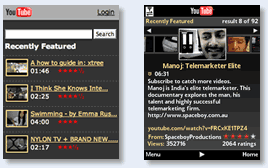 A recent consumer survey conducted by ABI Research shows that today’s mobile phone owners use a mix of mobile content obtained from the Web, from their personal collections, and from their wireless carriers. As an example, today’s mobile consumer is more likely to watch a video from YouTube on his or her phone than a video from the carrier’s own service, but is more than twice as likely to get ringtones from the carrier than from any other source.
A recent consumer survey conducted by ABI Research shows that today’s mobile phone owners use a mix of mobile content obtained from the Web, from their personal collections, and from their wireless carriers. As an example, today’s mobile consumer is more likely to watch a video from YouTube on his or her phone than a video from the carrier’s own service, but is more than twice as likely to get ringtones from the carrier than from any other source. “Perhaps more with the mobile phone than any other consumer electronics device, content is obtained from a variety of sources,” says research director Michael Wolf. “This shows that despite the strong control most carriers retain over the network, their control over the mobile content ecosystem remains limited. The consumer will see more and more options for obtaining rich media in the future.”
 mobile devices (28%). Music was also mixed: the leading source of music files on a mobile phone was ripped CDs and sideloading onto the phone (48% of mobile-music listening respondents), while over one third of music-listening respondents (35%) purchased music through their carriers. Lastly, pre-loaded content such as games were some of the most popular forms, as six in ten mobile gamers said they only play the games that came with the phone.
mobile devices (28%). Music was also mixed: the leading source of music files on a mobile phone was ripped CDs and sideloading onto the phone (48% of mobile-music listening respondents), while over one third of music-listening respondents (35%) purchased music through their carriers. Lastly, pre-loaded content such as games were some of the most popular forms, as six in ten mobile gamers said they only play the games that came with the phone.“As the mobile phone grows from being a voice-centric device to a multidimensional communication and entertainment device, content channels will continue to multiply,” adds Wolf. “We expect to see increased content acquisition directly to the phone from the Web. And despite a loosening of control over content delivery to consumers, we believe the carriers will ultimately benefit as they open up their networks and handset platforms and look into taking advantage of increased advertising-supported content delivery.”